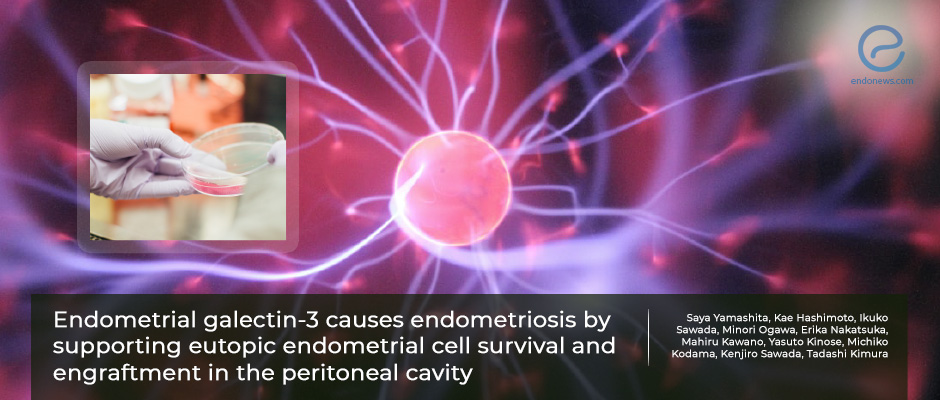A new potential therapeutic target in endometriosis: Galectin-3
Aug 5, 2022
Galectin-3, a cell surface molecule, was found to be increased in endometriosis
Key Points
Highlight
- Galectin-3, a cell surface molecule, may promote the engraftment of endometrial stromal cells in the peritoneal cavity; therefore, it may be a potential therapeutic target in endometriosis.
Importance
- The adhesion and migration of endometrial cells into the peritoneal cavity may be the mechanism that is partly responsible for the development of endometriosis.
- The altered immune system and proinflammatory environment contribute to the pathogenesis of the disease.
What’s done here
- This study aimed to investigate the role of Galectin-3 in the eutopic endometrium in patients with endometriosis.
- Eutopic endometrial tissues of the patients with and without endometriosis were obtained during surgery.
- The expression of cell surface molecules in eutopic endometrial stromal cells (ESCs) was evaluated.
- The tissues were analyzed using proteome analysis, immunohistochemistry, Western blot analysis, enzyme-linked immunosorbent assay, etc., and the results were statistically analyzed.
Key results
- Galectin-3 expression and secretion were significantly upregulated in patients with endometriosis.
- Galectin-3 did not affect cell viability and the proliferation of endometrial stromal cells.
- Galectin-3 significantly increased the adhesion of the stromal cells, especially to collagen IV, fibronectin, and human peritoneal mesothelial cells.
- Galectin-3 promoted the migration of the endometrial stromal cells to the peritoneum.
- Galectin-3 was found to reduce NK cell cytotoxicity toward the stromal cells.
Limitations
- The cause of some types that could not be explained by retrograde menstruation could not be explained.
- Endometrial stromal cells from patients without endometriosis were obtained from other gynecological diseases, such as uterine fibroids; therefore, their influence on the experiments could not be excluded.
- NK cells were prepared from the peripheral blood of healthy controls, which may not reflect the physiological conditions of endometriosis.
Lay Summary
The endometrial cells migrate and attach to the peritoneal surface according to the most widely accepted retrograde menstruation theory in endometriosis development. Given that only 10% of women have endometriosis, it is thought that some additional factors contribute to the disease progression, such as inflammatory environment and immune status.
The eutopic endometrium’s cell surface molecules have been investigated with the hypothesis that the eutopic endometrium’s molecular structure makes way for endometriosis development. Galectin-3, a cell surface molecule of the lectin family, has been found to be increased in eutopic endometrium in endometriosis. Dr. Yamashita and colleagues have performed a study in which they aimed to investigate the effect of Galectin-3 in endometriosis and identify the mechanisms responsible. The study was published in the June 2022 issue of the American Journal of Reproductive Immunology.
Eutopic endometrial tissues were obtained from the patients with and without endometriosis during the surgery. After acquiring the cell culture, proteome analysis was performed to assess the cell surface molecule expression in eutopic endometrial stromal cells.
Results showed that Galectin-3 expression and secretion in eutopic endometria were significantly upregulated in patients with endometriosis; therefore, it seems that it plays an essential role in the peritoneal engraftment of endometrial cells. Additionally, it was found that Galectin-3 did not affect cell viability and the proliferation of endometrial stromal cells. When cell adhesion was examined, Galectin-3 significantly increased the adhesion of the stromal cells, especially to collagen IV, fibronectin, and human peritoneal mesothelial cells. Galectin-3 also promoted the migration of the endometrial stromal cells to the peritoneum and reduced NK cell cytotoxicity toward the stromal cells in terms of immune surveillance. The authors declare that endometrial stromal cells escape immune surveillance with this mechanism.
They finally touched on the evidence that shows Galectin-3 to play a part in human cancers, making it a potential therapeutic target. They stated that Galectin-3 inhibitors might be a potential treatment method in endometriosis.
Research Source: https://pubmed.ncbi.nlm.nih.gov/35366371/
endometriosis Galectin-3 eutopic endometrium NK cells fibronectin immunsurveillance viability therapy diagnosis

